Present Climate Change as a Threat to Geoheritage: The Wildfire in Bohemian Switzerland National Park and Its Use in Place-Based Learning
Abstract
1. Introduction
2. Materials and Methods
2.1. Region
2.2. Connection of the Fire and Climate Change
- The instability of rocks predisposed by the regional geological structure and morphological conditions in the region and increased erosion (temperature has been demonstrated to be the primary factor influencing the reversible deformation of rock blocks through volumetric changes). This effect can potentially obscure the understanding of the inherent dynamics of slope movement and might even be a contributing factor to the dynamic forces involved in the intrinsic dynamics of slope failure systems [38];
- The shift of vegetation belts, better conditions for spreading pests (especially in spruce monocultures), higher demands for forest restoration, the withering of forest stands in unsuitable habitats, and unsuitable conditions for growing spruce;
- Drought and reduced water supply in the soil, drought stress, river flow reduction, and water resource levels drop;
- Increase in average annual water temperature, faster course of most unwanted chemical reactions and bacterial processes, a decrease of water quality, the influence of oxygen conditions, and changes in communities in watercourses;
- Increased incidence of windstorms endangering especially spruce forests;
- Deterioration of snow conditions.
2.3. Geographic Fieldwork Fundamentals
- In terms of time—short-term (several hours), medium-term, (one-day), and long-term (multi-day) education;Based on the landscape in which the teaching takes place—natural landscape, rural landscape, and urban landscape;
- From the point of view of teaching—teaching is conducted either by pupils, the teacher, or pupils in cooperation with the teacher (similarly, it is also possible to vary the question of teaching evaluation);
- From the point of view of the teaching schedule—teacher preparation in the field and research, the preparatory phase of pupils associated with motivation, involvement in the organization of teaching and familiarization with the place of teaching, the implementation phase in the field and the final phase of task processing, interpretation results and teaching evaluation.
- Biophysical, which pertains to the fundamental physical context of a place;
- Psychological, which concerns an individual’s unique experience within that physical place;
- Socio-cultural, which views a person as an integral part of a specific society and culture with ties to that place;
- Political-economic, which considers the political and economic processes that shape both place and people’s perspectives on it.
2.4. Methods
- What did you like best about today?
- What surprised you the most?
- What could have been better?
3. Results
3.1. Didactic Transfer of Assigned Topics
3.2. Evaluation of Feedback from Participants
3.2.1. Form of Activities—Research Teaching
3.2.2. Form of Activities—Field Education
3.2.3. Selection of Topics for Activities
3.2.4. The Program as a Whole
3.2.5. Links to Wildfires
3.2.6. Links to Climate Change
4. Discussion
5. Conclusions
Author Contributions
Funding
Institutional Review Board Statement
Informed Consent Statement
Data Availability Statement
Conflicts of Interest
References
- Gordon, J.E.; Wignall, R.M.L.; Brazier, V.; Crofts, R.; Tormey, D. Planning for Climate Change Impacts on Geoheritage Interests in Protected and Conserved Areas. Geoheritage 2002, 14, 126. [Google Scholar] [CrossRef]
- Gordon, J.E. Climate Change and Geotourism: Impacts, Challenges, and Opportunities. Tour. Hosp. 2023, 4, 514–538. [Google Scholar] [CrossRef]
- Howard, A.J. Managing global heritage in the face of future climate change: The importance of understanding geological and geomorphological processes and hazards. Int. J. Herit. Stud. 2013, 197, 632–658. [Google Scholar] [CrossRef]
- Selmi, L.; Canesin, T.S.; Gauci, R.; Pereira, P.; Coratza, P. Degradation Risk Assessment: Understanding the Impacts of Climate Change on Geoheritage. Sustainability 2022, 14, 4262. [Google Scholar] [CrossRef]
- Bollati, I.M.; Rossi, D.; Viani, C. Outdoor River Activities: Relations with Geological Background and Extreme Events in the Perspective of Geoeducation. Geosciences 2023, 13, 122. [Google Scholar] [CrossRef]
- Catana, M.M.; Brilha, J.B. The Role of UNESCO Global Geoparks in Promoting Geosciences Education for Sustainability. Geoheritage 2020, 12, 1. [Google Scholar] [CrossRef]
- Giardino, M.; Justice, S.; Olsbo, R.; Balzarini, P.; Magagna, A.; Viani, C.; Selvaggio, I.; Kiuttu, M.; Kauhanen, J.; Laukkanen, M.; et al. ERASMUS+ Strategic Partnerships between UNESCO Global Geoparks, Schools, and Research Institutions: A Window of Opportunity for Geoheritage Enhancement and Geoscience Education. Heritage 2022, 5, 677–701. [Google Scholar] [CrossRef]
- Vegas, J.; Baeza, E.; Cabrera, A.; Diez-Herrero, A.; Ferrer, N.; Galindo, I.; Garrote, J.; Gonzalez-Laguna, R.; Herrera, R.; Lario, J.; et al. Impacts, vulnerability and resilience of Geoheritage to Climate Change in the four Canary Islands National Parks (Spain). In Proceedings of the 10th International Conference on Geomorphology, Coimbra, Portugal, 12–16 September 2022. ICG2022-194. [Google Scholar]
- Kołodziejczyk, K. Tourist management in national parks in the Czech-German borderland: Bohemian ‘Switzerland‘ and Saxon ‘Switzerland’. J. Mt. Sci. 2020, 17, 2853–2879. [Google Scholar] [CrossRef]
- Štěbetáková, M.; Hruška, V.; Raška, P. Bohemian Switzerland: Long-Term Spatiotemporal Transformations of Tourism Facilities in Rural Peripheries Between the Regulations and Access for All. Eur. Countrys. 2022, 14, 328–345. [Google Scholar] [CrossRef]
- Vaishar, A.; Dvořák, P.; Nosková, H.; Zapletalová, J. Present consequences of the post-war migration in the Czech borderland for regional development. Quaest. Geogr. 2017, 36, 5–15. [Google Scholar] [CrossRef][Green Version]
- Krkoška Lorencová, E.; Loučková, B.; Vačkářů, D. Perception of Climate Change Risk and Adaptation in the Czech Republic. Climate 2019, 7, 61. [Google Scholar] [CrossRef]
- Ocelík, P. Climate change scepticism in front-page Czech newspaper coverage: A one man show. In Handbook of Anti-Environmentalism; Tindall, D., Stoddart, M.C.J., Dunlap, R.E., Eds.; Edward Elgar Publishing: Cheltenham, UK, 2022; pp. 84–106. [Google Scholar] [CrossRef]
- Meitner, J.; Balek, J.; Bláhová, M.; Semerádová, D.; Hlavinka, P.; Lukas, V.; Jurečka, F.; Žalud, Z.; Klem, K.; Anderson, M.C.; et al. Estimating Drought-Induced Crop Yield Losses at the Cadastral Area Level in the Czech Republic. Agronomy 2023, 13, 1669. [Google Scholar] [CrossRef]
- Lohmander, P.; Mohammadi, Z.; Kašpar, J.; Tahri, M.; Berčák, R.; Holuša, J.; Marušák, R. Future forest fires as functions of climate change and attack time for central Bohemian region, Czech Republic. Ann. For. Res. 2022, 65, 17–30. [Google Scholar] [CrossRef]
- San-Miguel-Ayanz, J.; Durrant, T.; Boca, R.; Maianti, P.; Liberta’, G.; Artes Vivancos, T.; Jacome Felix Oom, D.; Branco, A.; de Rigo, D.; Ferrari, D.; et al. Forest Fires in Europe, Middle East and North Africa 2021; Publications Office of the European Union: Luxembourg, Luxembourg, 2022. [Google Scholar]
- Jaagus, J.; Aasa, A.; Aniskevich, S.; Boincean, B.; Bojariu, R.; Briede, A.; Danilovich, I.; Castro, F.D.; Dumitrescu, A.; Labuda, M.; et al. Long-term changes in drought indices in eastern and central Europe. Int. J. Climatol. 2022, 42, 225–249. [Google Scholar] [CrossRef]
- Korčák, M.; Netrdová, P. Historická hranice Sudet a současná sociálně-prostorová diferenciace Česka: Kvantitativní pohled na dlouhodobý dopad institucionálních změn (The historical border of the Sudetenland and the current socio-spatial differentiation of Czechia: A quantitative view of the long-term impact of institutional changes). Geografie 2022, 127, 365–390. [Google Scholar] [CrossRef]
- Hruška, J.; Balek, J.; Beranová, J.; Bláhová, M.; Bobek, P.; Ciencala, E.; Homolová, L.; Kudláčková, L.; Krajhanzl, J.; Možný, M.; et al. Jaké Faktory Ovlivnily Vznik Požáru v NP České Švýcarsko? (What Factors Influenced the Origin of the Fire in Bohemian Switzerland NP? Scientific Study for the Ministry of Environment of the Czech Republic. 2022. Available online: https://www.mzp.cz/C1257458002F0DC7/cz/news_20220106-Vedci-zmapovali-pozar-v-Ceskem-Svycarsku-Majitele-lesu-se-z-nej-musi-ponaucit-Pro-prirodu-ale-znamena-probihajici-obnova-velkou-sanci/$FILE/Studie_faktoru_pozaru_Narodni_park_Ceske_Svycarsko.pdf (accessed on 3 September 2023).
- Milanović, S.; Trailović, Z.; Milanović, S.D.; Hochbichler, E.; Kirisits, T.; Immitzer, M.; Čermák, P.; Pokorný, R.; Jankovský, L.; Jaafari, A. Country-Level Modeling of Forest Fires in Austria and the Czech Republic: Insights from Open-Source Data. Sustainability 2023, 15, 5269. [Google Scholar] [CrossRef]
- Cílek, V. Saxon-Bohemian Switzerland: Sandstone Rock Cities and Fascination in a Romantic Landscape. In Geomorphological Landscapes of the World; Migoń, P., Ed.; Springer: Berlin/Heidelberg, Germany, 2010; pp. 201–209. [Google Scholar]
- Zvelebil, J.; Vařilová, Z.; Paluš, M. Tools for Rock Fall Risk Integrated Management in Sandstone Landscape of the Bohemian Switzerland National Park, Czech Republic (M121). In Landslides: Risk Analysis and Sustainable Disaster Management; Sassa, K., Fukuoka, H., Wang, F., Wang, G., Eds.; Springer: Berlin/Heidelberg, Germany, 2005; pp. 119–126. [Google Scholar] [CrossRef]
- Bruthans, J.; Soukup, J.; Vaculikova, J.; Filippi, M.; Schweigstillova, J.; Mayo, A.L.; Masin, D.; Kletetschka, G.; Rihosek, J. Sandstone landforms shaped by negative feedback between stress and erosion. Nat. Geosci. 2014, 7, 597–601. [Google Scholar] [CrossRef]
- Vařilová, Z.; Navrátil, T.; Dobešová, I. Recent Atmospheric Deposition and its Effects on Sandstone Cliffs in Bohemian Switzerland National Park, Czech Republic. Water Air Soil Pollut. 2011, 220, 117–130. [Google Scholar] [CrossRef]
- Waldron, J.W.F.; Locock, J.; Pujadas-Botey, A. Building an Outdoor Classroom for Field Geology: The Geoscience Garden. J. Geosci. Educ. 2016, 64, 215–230. [Google Scholar] [CrossRef]
- Kent, M.; Gilbertson, D.; Hunt, C.O. Fieldwork in geography teaching: A critical review of the literature and approaches. J. Geogr. High. Educ. 1997, 21, 313–332. [Google Scholar] [CrossRef]
- Steward, K.C.; Bhattacharya, D.; Chandler, M.; Forbes, C.T. Secondary science teachers’ implementation of a curricular intervention when teaching with global climate models. J. Geosci. Educ. 2022, 70, 474–489. [Google Scholar] [CrossRef]
- Meadows, M. Geography Education for Sustainable Development. Geogr. Sustain. 2020, 1, 88–92. [Google Scholar] [CrossRef]
- Mönter, L.; Otto, K. The concept of disasters in Geography Education. J. Geogr. High. Educ. 2018, 42, 205–219. [Google Scholar] [CrossRef]
- Quitt, E. Klimatické Oblasti Československa (Climate Regions of Czechoslovakia); Academia: Prague, Czech Republic, 1971. [Google Scholar]
- Patacca, M.; Lindner, M.; Lucas-Borja, M.E.; Cordonnier, T.; Fidej, G.; Gardiner, B.; Hauf, Y.; Jasinevičius, G.; Labonne, S.; Linkevičius, E.; et al. Significant increase in natural disturbance impacts on European forests since 1950. Glob. Chang. Biol. 2023, 29, 1359–1376. [Google Scholar] [CrossRef] [PubMed]
- Možný, M.; Trnka, M.; Brázdil, R. Climate change driven changes of vegetation fires in the Czech Republic. Theor. Appl. Climatol. 2021, 143, 691–699. [Google Scholar] [CrossRef]
- Trnka, M.; Balek, J.; Možný, M.; Cienciala, E.; Čermák, P.; Semerádová, D.; Jurečka, F.; Hlavinka, P.; Štěpánek, P.; Farda, A.; et al. Observed and expected changes in wildfire-conducive weather and fire events in peri-urban zones and key nature reserves of the Czech Republic. Clim. Res. 2020, 82, 33–54. [Google Scholar] [CrossRef]
- Moravec, V.; Markonis, Y.; Rakovec, O.; Svoboda, M.; Trnka, M.; Kumar, R.; Hanel, M. Europe under multi-year droughts: How severe was the 2014-2018 drought period? Environ. Res. Lett. 2021, 16, 034062. [Google Scholar] [CrossRef]
- Změna Klimatu v ČR (Climate Change in Czechia); Czech Hydrometeorological Institute: Prague, Czech Republic, 2023; Available online: https://www.chmi.cz/files/portal/docs/meteo/ok/klimazmena/files/cc_chap10.pdf (accessed on 1 September 2023).
- Kocinová, M.; Nedělníková, H. Statistical Yearbook 2021 of the Fire Rescue Service of the Czech Republic; Fire Rescue Service of the Czech Republic: Prague, Czech Republic, 2021. [Google Scholar]
- Blahová, M.; Frélich, Z.; Karkoszková, Z.; Misiaček, R.; Trojáčková, Z. Studie Potřeb Obcí Regionu NP České Švýcarsko v Oblasti Ochrany ŽP a Udržitelného Rozvoje Obcí (Study of the Needs of Municipalities in the Bohemian Switzerland NP Region in the Area of Environmental Protection and Sustainable Development of Municipalities); RADDIT Consulting: Krmelín, Czech Republic, 2020; Available online: https://www.ceskesvycarsko.cz/sites/default/files/inline-files/Studie%20pot%C5%99eb_obc%C3%AD_NP%C4%8C%C5%A0_pro_SF%C5%BDP-formal_fin_0.pdf (accessed on 4 September 2023).
- Paluš, M.; Novotná, D.; Zvelebil, J. Fractal rock slope dynamics anticipating collapse. Phys. Rev. E 2004, 70, 36212. [Google Scholar] [CrossRef]
- Buček, A.; Lacina, J. Geobiocenologie II: Geobiocenologická Typologie Krajiny České Republiky (Geobiocenology II: Geobiocenological Typology of the Landscape of the Czech Republic); Mendelova Zemědělská a Lesnická Univerzita: Brno, Czech Republic, 1999. [Google Scholar]
- Patzelt, Z. Mimořádná Událost—Požár v Národním Parku České Švýcarsko (Extraordinary Event—Fire in the Bohemian Switzerland National Park). Ochr. Přírody 2022, 4, 45–48. [Google Scholar]
- Biró, A.; Hlavička, V.; Lublóy, E. Effect of fire-related temperatures on natural stones. Constr. Build. Mater. 2019, 212, 92–101. [Google Scholar] [CrossRef]
- Svobodová, H.; Mísařová, D.; Durna, R.; Hofmann, E. Geography Outdoor Education from the Perspective of Czech Teachers, Pupils and Parents. J. Geogr. 2020, 119, 32–41. [Google Scholar] [CrossRef]
- Svobodová, H.; Mísařová, D.; Durna, R.; Češková, T.; Hofmann, E. Koncepce Terénní Výuky pro Základní Školy (Conception of Fieldwork for Basic Schools); Masarykova Univerzita: Brno, Czech Republic, 2019. [Google Scholar]
- Krathwohl, D.R. A Revision of Bloom’s Taxonomy: An Overview. Theory Into Pract. 2002, 41, 212–218. [Google Scholar] [CrossRef]
- Rámcový Vzdělávací Program pro Základní Školy (Framework Educational Program for Basic Education); MŠMT: Praha, Czech Republic, 2023; Available online: https://www.edu.cz/rvp-ramcove-vzdelavaci-programy/ramcovy-vzdelavacici-program-pro-zakladni-vzdelavani-rvp-zv (accessed on 28 August 2023).
- Rámcový Vzdělávací Program pro Gymnázia (Framework Educational Program for Grammar Schools); MŠMT: Praha, Czech Republic, 2023; Available online: https://www.edu.cz/rvp-ramcove-vzdelavaci-programy/ramcove-vzdelavaci-programy-pro-gymnazia-rvp-g (accessed on 28 August 2023).
- The 2016 International Charter on Geographical Education; International Geographical Union: Amsterdam, The Netherlands, 2016; Available online: https://www.igu-cge.org/wp-content/uploads/2019/03/IGU_2016_eng_ver25Feb2019.pdf (accessed on 29 August 2023).
- Gruenewald, D.A. Foundations of place: A multidisciplinary framework for place-conscious education. Am. Educ. Res. J. 2003, 40, 619–654. [Google Scholar] [CrossRef]
- Triantaphyllou, M.V.; Firkasis, N.; Tsourou, T.; Vassilakis, E.; Spyrou, E.; Koukousioura, O.; Oikonomou, A.; Skentos, A. “Geo-Archaeo-Routes” on the Island of Lemnos: The “Nalture” Experience as a Holistic Geotouristic Approach within the Geoethical Perspective. Geosciences 2023, 13, 143. [Google Scholar] [CrossRef]
- Schild, R. Environmental citizenship: What can political theory contribute to environmental education practice? J. Environ. Educ. 2016, 47, 19–34. [Google Scholar] [CrossRef]
- Israel, A.L. Putting geography education into place: What geography educators can learn from Place-Based Education, and vice versa. J. Geogr. 2012, 111, 76–81. [Google Scholar] [CrossRef]
- Ardoin, N.M.; Schuh, J.S.; Gould, R.K. Exploring the dimensions of place: A confirmatory factor analysis of data from three ecoregional sites. Environ. Educ. Res. 2012, 18, 583–607. [Google Scholar] [CrossRef]
- Drápela, E. Assessing the Educational Potential of Geosites: Introducing a Method Using Inquiry-Based Learning. Resources 2022, 11, 101. [Google Scholar] [CrossRef]
- Briggs, M. Qualitative Assessment of Inquiry-Based Teaching Methods. J. Chem. Educ. 2011, 88, 1034–1040. [Google Scholar] [CrossRef]
- Karamustafaogu, S.; Havuz, A.C. Inquiry Based Learning and Its Effectiveness. Int. J. Assesment Tools Educ. 2016, 3, 40–54. [Google Scholar]
- Drápela, E. Using a Geotrail for Teaching Geography: An Example of the Virtual Educational Trail “The Story of Liberec Granite”. Land 2023, 12, 828. [Google Scholar] [CrossRef]
- Peppoloni, S.; Di Capua, G. Geoethics and geological culture: Awareness, responsibility and challenges. Ann. Geophys. 2012, 55, 335–341. [Google Scholar] [CrossRef]
- Peppoloni, S.; Di Capua, G. The Meaning of Geoethics. In Geoethics: Ethical Challenges and Case Studies in Earth Sciences; Wyss, M., Peppoloni, S., Eds.; Elsevier: Amsterdam, The Netherlands, 2015; pp. 3–14. [Google Scholar]
- Peppoloni, S.; Di Capua, G. The significance of geotourism through the lens of geoethics. In Proceedings of the EGU General Assembly 2022, Vienna, Austria, 23–28 May 2022; EGU: Vienna, Austria, 1756. [Google Scholar]
- Drápela, E. Prevention of damage to sandstone rocks in protected areas of nature in northern Bohemia. AIMS Geosci. 2021, 7, 56–73. [Google Scholar] [CrossRef]
- Učíme Badatelsky (We Teach by Research). Available online: https://www.ucimebadatelsky.cz/ (accessed on 28 August 2023).
- Badatelé (Researchers). Available online: https://badatele.cz/ (accessed on 28 August 2023).
- Program GLOBE (GLOBE Program). Available online: https://globe-czech.cz/cz (accessed on 28 August 2023).
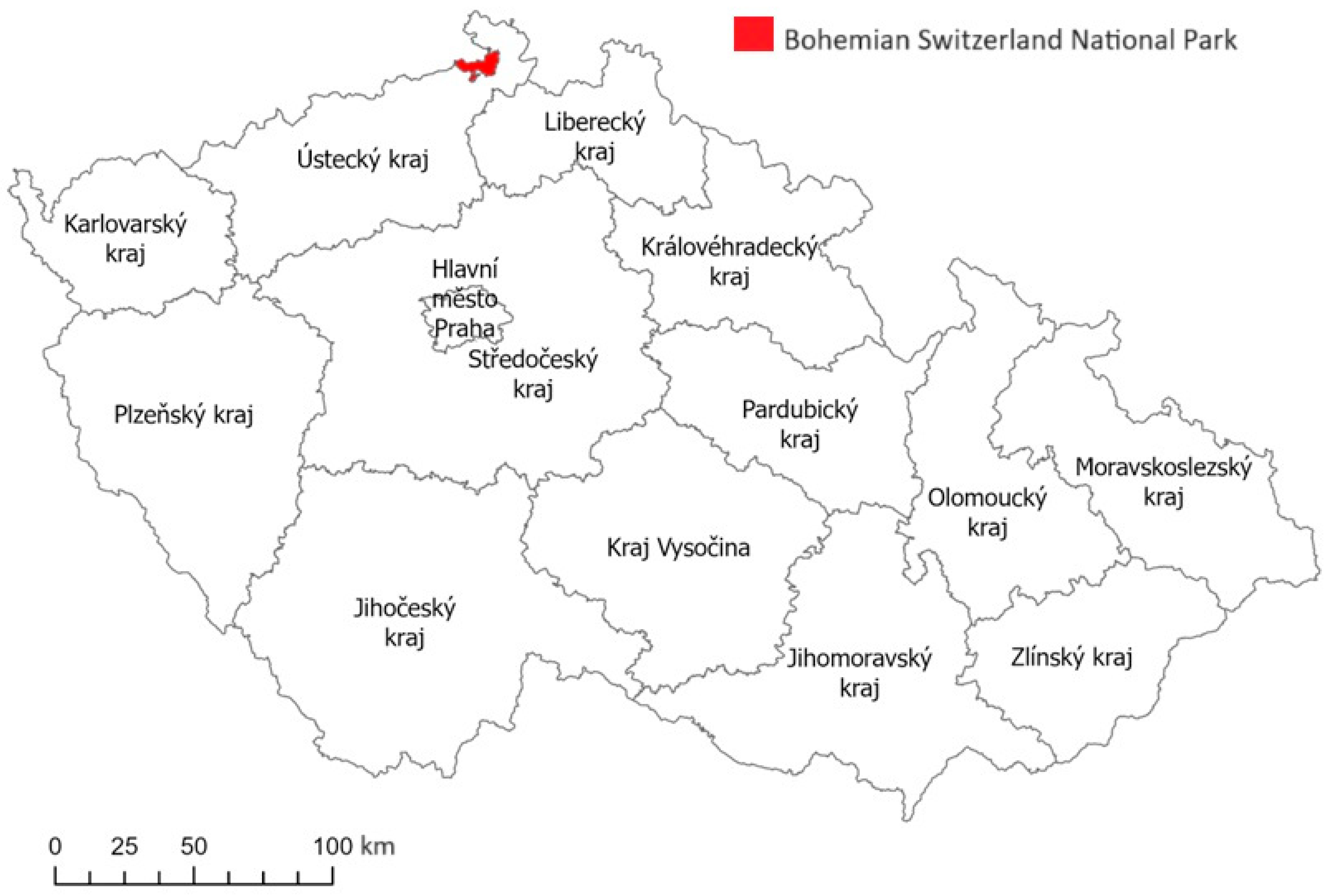
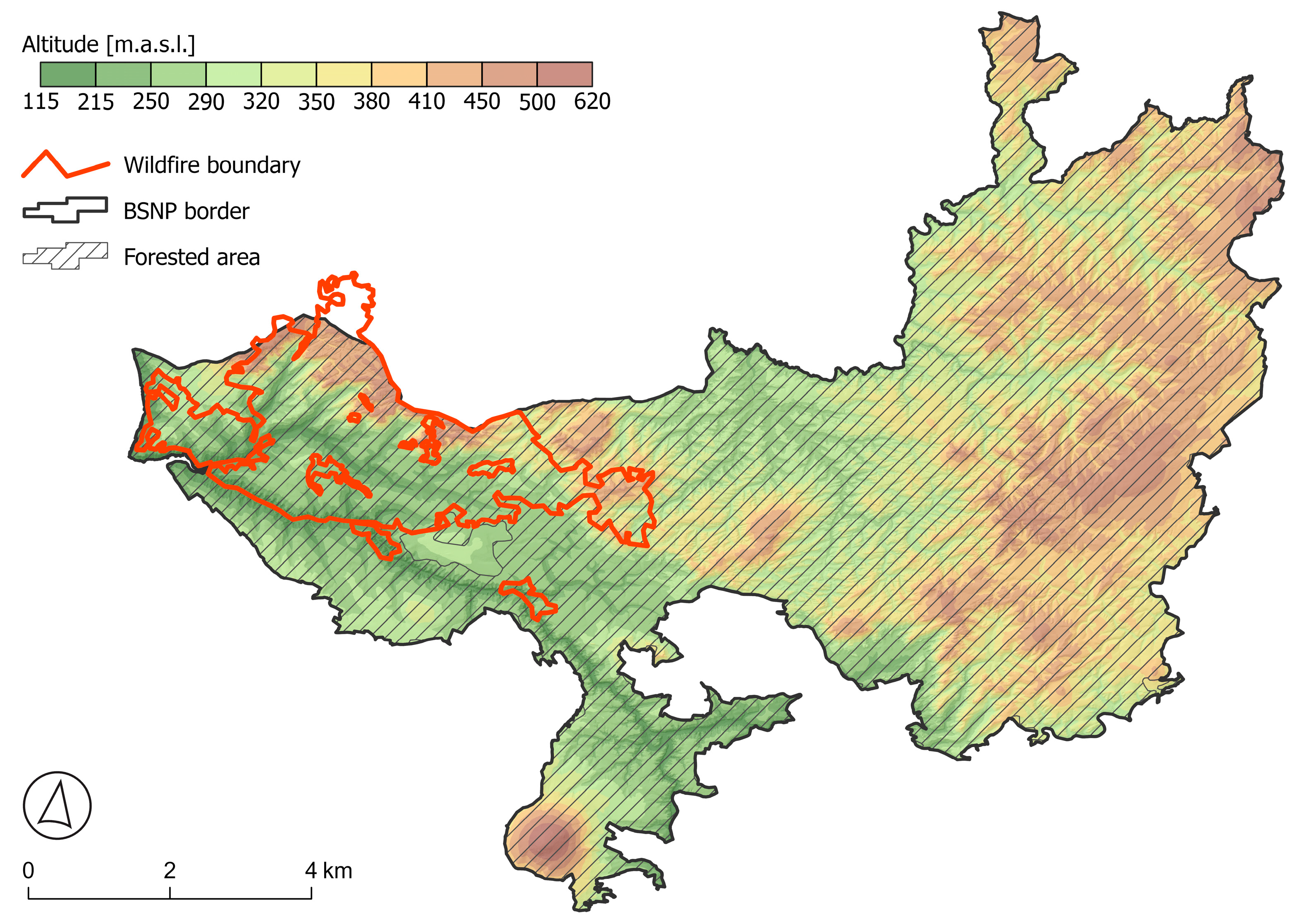
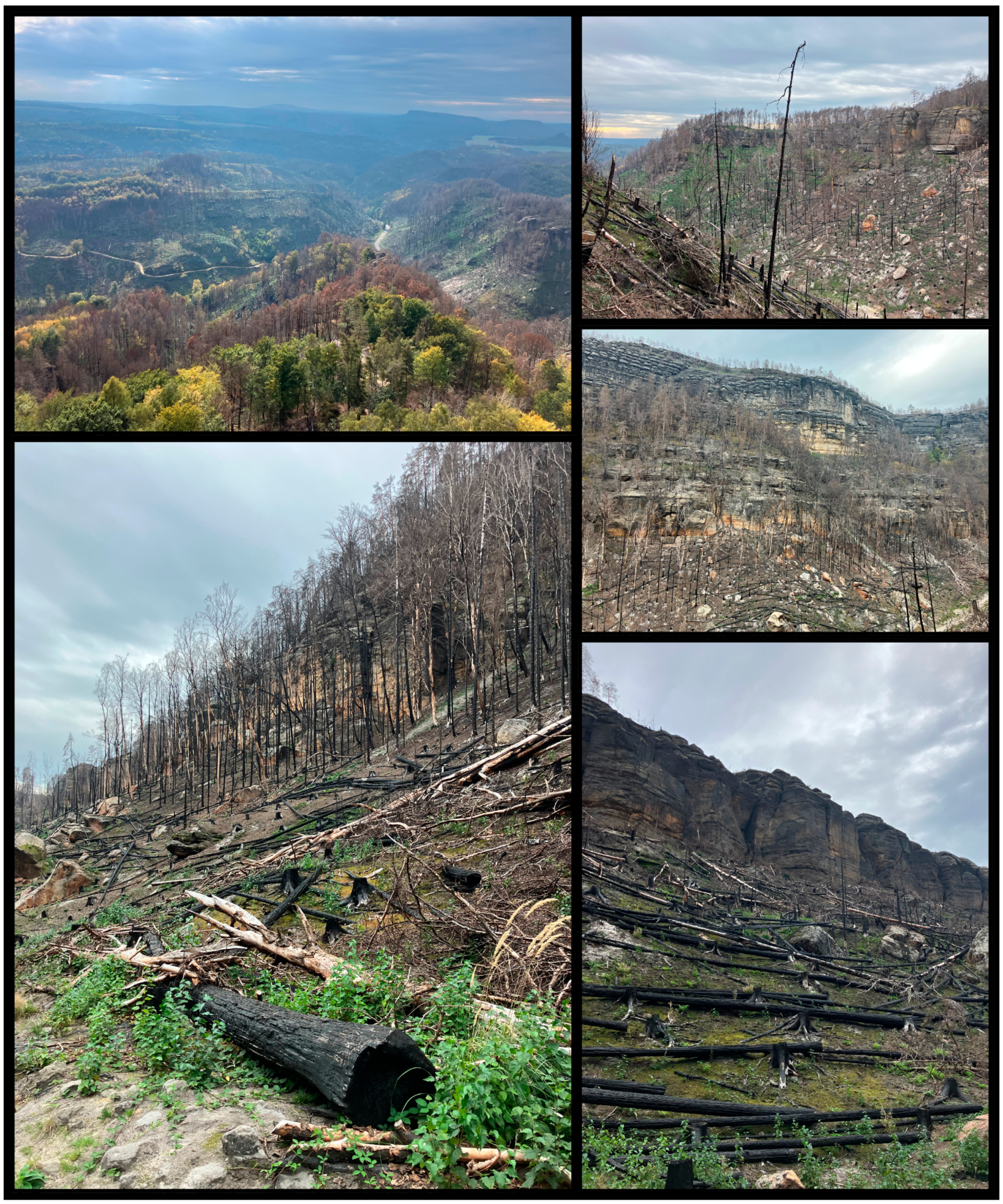
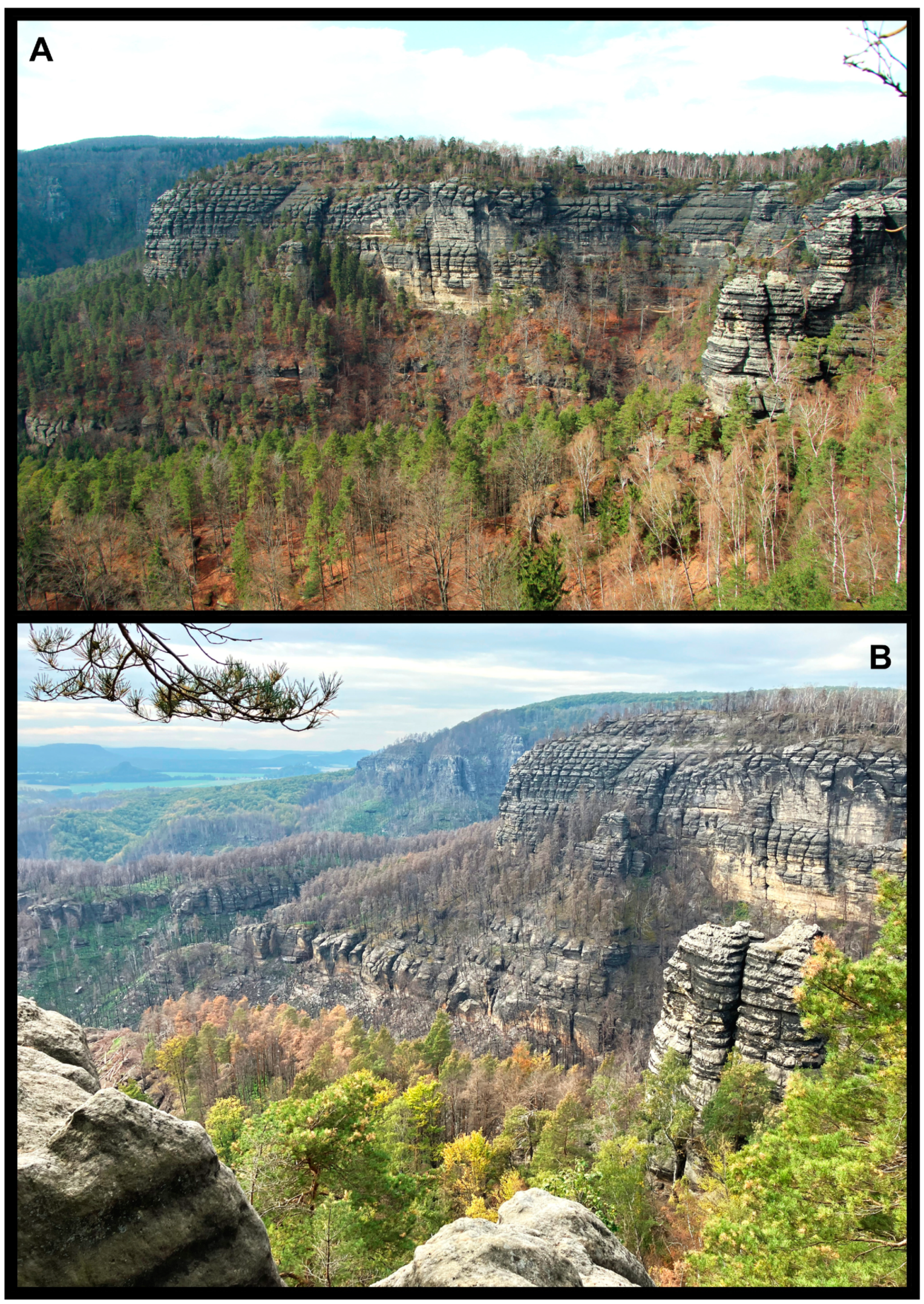
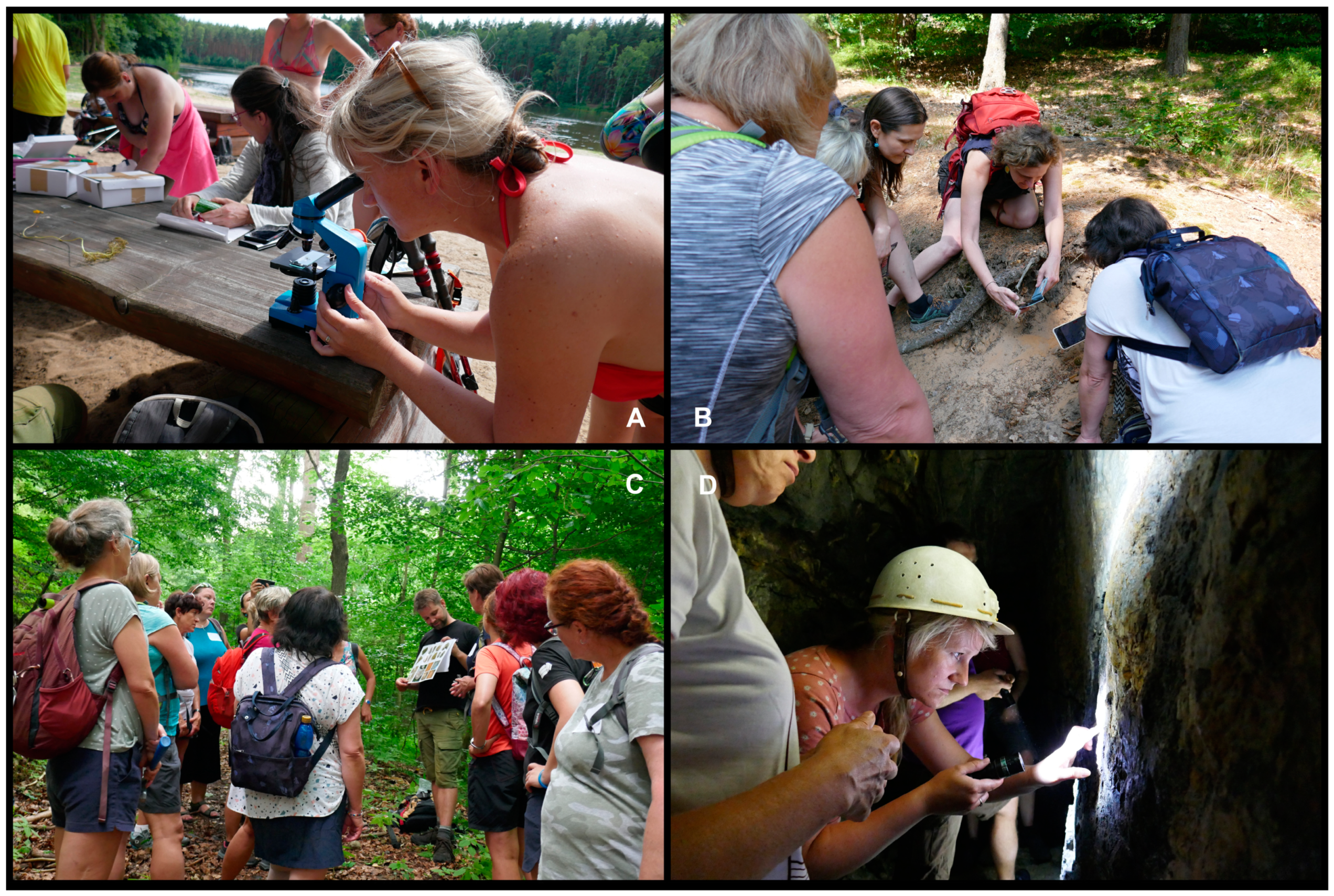
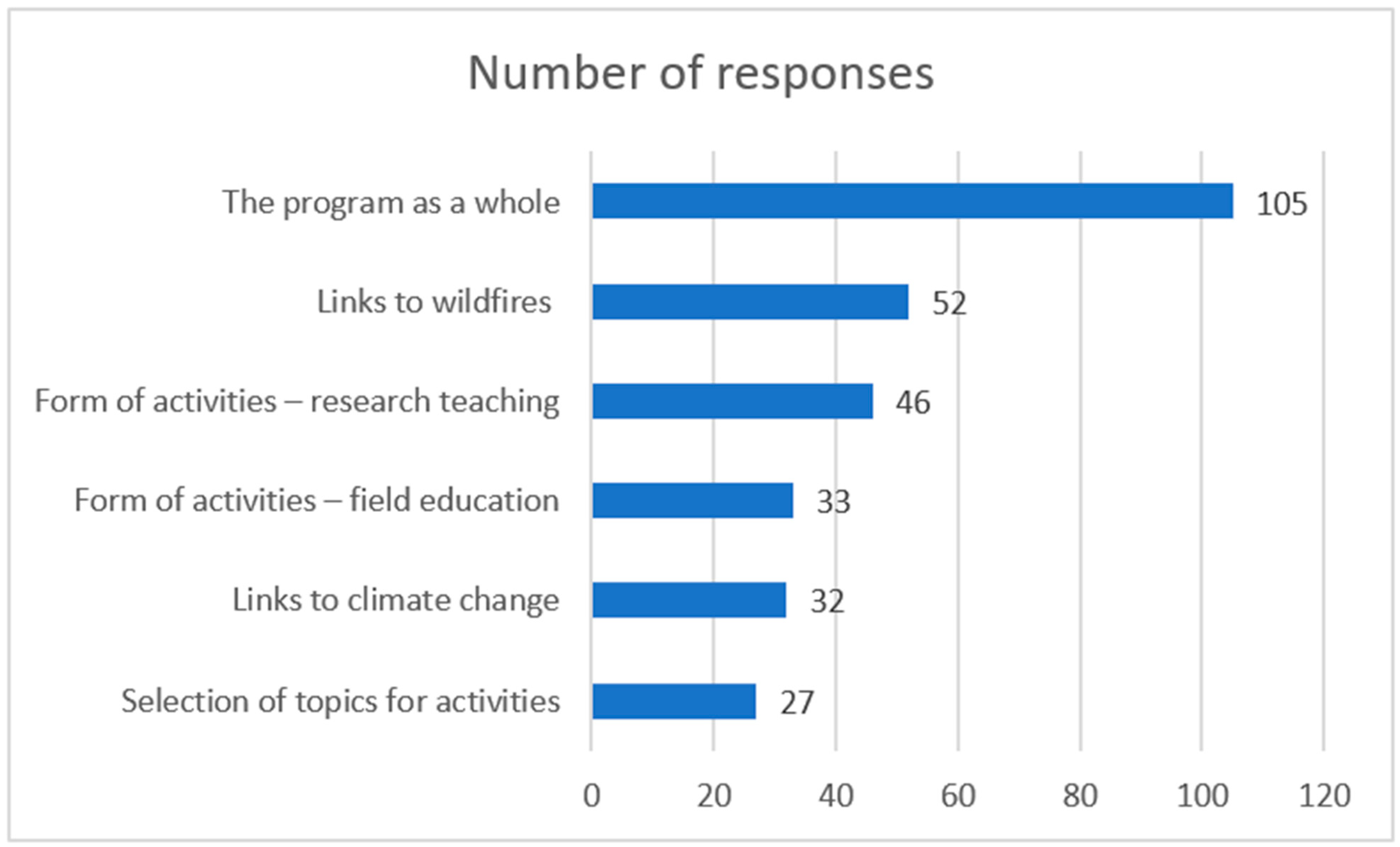
| Topic | Examples of Activities | Key Insight |
|---|---|---|
| Geology | Rocks from the surroundings—exploring with a geological hammer | Most of the bedrock in the national park is a thick layer of Cretaceous sandstone. |
| Geomorphology | Sandstone relief shapes of geosites—search and find the shape from the photo | Attractive rock towns have been created here thanks to a specific type of sandstone erosion. |
| Hydrology | Experiment with pouring water over sandstone, granite, and basalt | Sandstone is easily permeable to water and builds up groundwater reserves, but on the other hand, it dries out quickly in the surface layer. The number of surface watercourses is relatively tiny. |
| Climate | Comparison of climate maps from 1960–1990 and 1990–2020 | The climate in the region is mild, but in recent decades there have been frequent droughts in summer. |
| Soils | Digging a “hole” with a soil probe | The soils are light, sandy, and strongly acidic, with little nutrient supply. |
| Biota | Search for different plant species and identify them using PlantNet | Natural ecosystems should be predominantly acidophilous beech forests, which are, however, being converted to monocultures of spruce and pine as a result of forestry. The area’s high forest cover is favorable to several species of fauna. |
| Agriculture | Making a roller out of soil—analysis of its suitability for agriculture | Due to the low amount of nutrients in the soil and its high sandiness, agriculture is not very active here. |
| Forestry | Search for different types of trees at the edges of the forest and in its interior | Because the area has not been used for agriculture in the past, 97% of the national park is covered by forests. The current forests are monocultures of spruce and pine, with spruce forests having major problems with bark beetle calamities in recent decades. |
| Tourism | What is left of the people here? A field survey of human damage to ecosystems. | The attractiveness of the natural environment in the national park causes a significant increase in the number of incoming tourists. Mass tourism can be a serious threat to ecosystems. |
| Form of Activities—Research Teaching | Form of Activities—Field Education | Selection of Topics for Activities | The Program as a Whole | Links to Wildfires | Links to Climate Change | |
|---|---|---|---|---|---|---|
| Form of activities—research teaching | 46 | |||||
| Form of activities—field education | 12 | 33 | ||||
| Selection of topics for activities | 7 | 9 | 27 | |||
| The program as a whole | 42 | 23 | 11 | 105 | ||
| Links to wildfires | 31 | 3 | 17 | 23 | 52 | |
| Links to climate change | 13 | 4 | 6 | 27 | 19 | 32 |
Disclaimer/Publisher’s Note: The statements, opinions and data contained in all publications are solely those of the individual author(s) and contributor(s) and not of MDPI and/or the editor(s). MDPI and/or the editor(s) disclaim responsibility for any injury to people or property resulting from any ideas, methods, instructions or products referred to in the content. |
© 2023 by the authors. Licensee MDPI, Basel, Switzerland. This article is an open access article distributed under the terms and conditions of the Creative Commons Attribution (CC BY) license (https://creativecommons.org/licenses/by/4.0/).
Share and Cite
Boháč, A.; Drápela, E. Present Climate Change as a Threat to Geoheritage: The Wildfire in Bohemian Switzerland National Park and Its Use in Place-Based Learning. Geosciences 2023, 13, 383. https://doi.org/10.3390/geosciences13120383
Boháč A, Drápela E. Present Climate Change as a Threat to Geoheritage: The Wildfire in Bohemian Switzerland National Park and Its Use in Place-Based Learning. Geosciences. 2023; 13(12):383. https://doi.org/10.3390/geosciences13120383
Chicago/Turabian StyleBoháč, Artur, and Emil Drápela. 2023. "Present Climate Change as a Threat to Geoheritage: The Wildfire in Bohemian Switzerland National Park and Its Use in Place-Based Learning" Geosciences 13, no. 12: 383. https://doi.org/10.3390/geosciences13120383
APA StyleBoháč, A., & Drápela, E. (2023). Present Climate Change as a Threat to Geoheritage: The Wildfire in Bohemian Switzerland National Park and Its Use in Place-Based Learning. Geosciences, 13(12), 383. https://doi.org/10.3390/geosciences13120383






